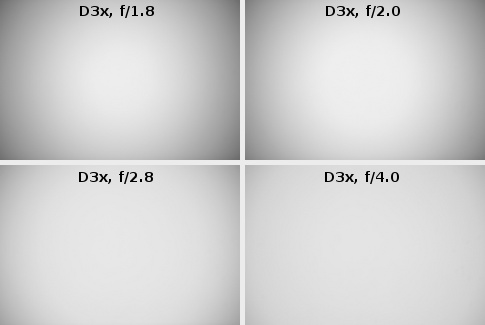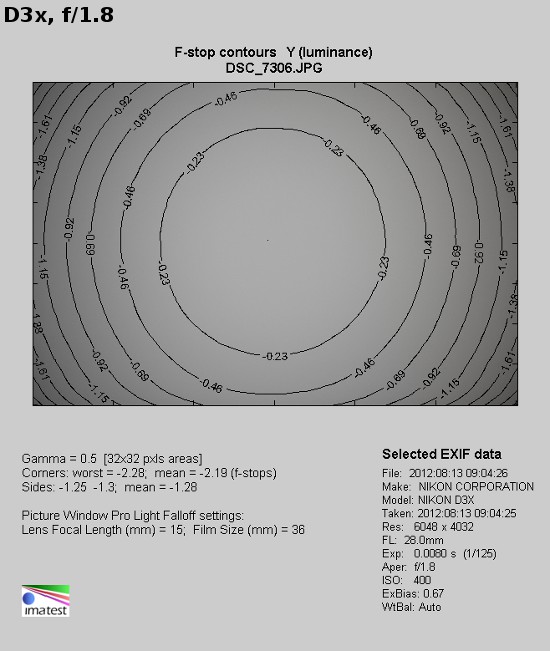Nikon Nikkor AF-S 28 mm f/1.8G
8. Vignetting

As you see it is clearly visible at the maximum relative aperture, amounting there to 33% (-1.14 EV). You can also notice it by f/2.0 where it gets to 26% (-0.87 EV). That aberration disappears by f/2.8 where it reaches just 10% (-0.32 EV) . How these achievements compare to those of the rivals? The chart below present them all.
Please Support UsIf you enjoy our reviews and articles, and you want us to continue our work please, support our website by donating through PayPal. The funds are going to be used for paying our editorial team, renting servers, and equipping our testing studio; only that way we will be able to continue providing you interesting content for free. |
- - - - - - - - - - - - - - - - - - - - - - - - - - - - - - - - - - - - - - - - - - - - - - - -
| |
Nikkor AF-S 1.8/28 |
Canon EF 1.8/28 |
Sigma EX 1.8/28 |
Zeiss 2.0/28 |
| f/1.8 |
33% |
22% |
39% |
- |
| f/2.0 |
26% |
15% |
33% |
36% |
| f/2.8 |
10% |
9% |
14% |
13% |
Let’s progress now to the performance on full frame – here you get the most serious problems more often than not; the tested Nikkor 1.8/28G didn’t manage to avoid them as well.

At the maximum relative aperture you can see high vignetting which value we assessed as 53% (-2.19 EV). By f/2.0 it is hardly much lower, amounting to 48% (-1.88 EV) The brightness loss in the frame corners is also visible by f/2.8 where it reaches 31% (-1.07 EV). Only by f/4.0 and f/5.6 we deal with a moderate level of that aberration as it is respectively 19% (-0.62 EV) and 14% (-0.45 EV). On further stopping down the aperture you can’t notice any improvement because the vignetting keeps the level near 13% (-0.40 EV).
The chart below shows a comparison between the performance of the Nikkor and that of its rivals. As you see all lenses present very similar results. What’s interesting it’s the Sigma 1.8/28, with the biggest front element (its filter is 77 mm in diameter) fares the worst here.
| |
Nikkor AF-S 1.8/28 |
Canon EF 1.8/28 |
Sigma EX 1.8/28 |
| f/1.8 |
53% |
52% |
59% |
| f/2.0 |
48% |
45% |
54% |
| f/2.8 |
31% |
28% |
34% |
| f/4.0 |
19% |
22% |
25% |
 |






